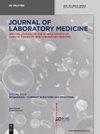使用回归树模型自动划分性别和年龄以估算参考区间
IF 1.8
4区 医学
Q4 MEDICAL LABORATORY TECHNOLOGY
引用次数: 0
摘要
目标 参考区间(RI)在解释医学实验室结果中起着决定性作用。确定参考区间的一个重要步骤是根据年龄和性别进行分区,这通常是通过图形表示的经验方法进行的。在本研究中,我们对一种自动机器学习方法进行了评估。方法 本研究使用的儿科数据来自 CALIPER RI(加拿大儿科参考区间实验室倡议)研究。使用统计编程语言 R 的 rpart 软件包中的回归树模型计算潜在的分区。Harris & Boyd 方法用于比较 rpart 和 CALIPER 提出的相应分区。为了更好地进行比较,还使用 reflimR 计算了两种方法的分区参考范围。结果 rpart 或 CALIPER 提出的大多数分区都显示出了足够的异质性,因此有理由对不同年龄和/或性别的 RI 进行分区。除了个别例外情况,两种方法得出的结果具有可比性。两种方法对白蛋白和 γ-谷氨酰转移酶的分区结果非常相似。就肌酐而言,rpart 表明性别差异稍早。碱性磷酸酶的差异最为明显。除了较早出现性别分化外,rpart 还显示男女的年龄间隔不同,女性分为三个部分,男性分为四个部分。结论 我们的研究结果表明,rpart 提供的自动分析结果与传统方法不相上下。不过,自动建议的医学合理性还需要人类专家的验证。本文章由计算机程序翻译,如有差异,请以英文原文为准。
Automated sex and age partitioning for the estimation of reference intervals using a regression tree model
Objectives Reference intervals (RI) play a decisive role in the interpretation of medical laboratory results. An important step in the determination of RI is age- and sex specific partitioning, which is usually based on an empirical approach by graphical representation. In this study, we evaluate an automated machine learning approach. Methods This study uses pediatric data from the CALIPER RI (Canadian laboratory initiative on pediatric reference intervals) study. The calculation of potential partitions is carried out using a regression tree model included in the rpart package of the statistical programming language R. The Harris & Boyd method is used to compare the corresponding partitions suggested by rpart and CALIPER. For better comparability, the reference ranges of the partitions of both approaches are then calculated using reflimR . Results Most of the partitions suggested by rpart or CALIPER show sufficient heterogeneity among themselves to justify age- and/or sex-specific RI partitioning. With only few individual exceptions, both methods yield comparable results. The partitions of both approaches for albumin and γ -glutamyltransferase are very similar to each other. For creatinine rpart suggests a slightly earlier distinction between the sexes. Alkaline phosphatase shows the most pronounced differences. In addition to a considerable earlier sex split, rpart suggests different age intervals for both sexes, resulting in three partitions for females and four partitions for males. Conclusions Our findings indicate that the automated analysis provided by rpart yields results that comparable to traditional methods. Nevertheless, the medical plausibility of the automatic suggestions needs to be validated by human experts.
求助全文
通过发布文献求助,成功后即可免费获取论文全文。
去求助
来源期刊

Journal of Laboratory Medicine
Mathematics-Discrete Mathematics and Combinatorics
CiteScore
2.50
自引率
0.00%
发文量
39
审稿时长
10 weeks
期刊介绍:
The Journal of Laboratory Medicine (JLM) is a bi-monthly published journal that reports on the latest developments in laboratory medicine. Particular focus is placed on the diagnostic aspects of the clinical laboratory, although technical, regulatory, and educational topics are equally covered. The Journal specializes in the publication of high-standard, competent and timely review articles on clinical, methodological and pathogenic aspects of modern laboratory diagnostics. These reviews are critically reviewed by expert reviewers and JLM’s Associate Editors who are specialists in the various subdisciplines of laboratory medicine. In addition, JLM publishes original research articles, case reports, point/counterpoint articles and letters to the editor, all of which are peer reviewed by at least two experts in the field.
 求助内容:
求助内容: 应助结果提醒方式:
应助结果提醒方式:


